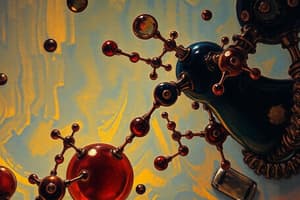Podcast
Questions and Answers
In which type of reactions is NADPH primarily used?
In which type of reactions is NADPH primarily used?
Anabolic reactions
What is the overall standard Gibbs free energy change for the breakdown of glucose in cellular respiration?
What is the overall standard Gibbs free energy change for the breakdown of glucose in cellular respiration?
-2872.2 kJ
Where does the oxidation half-reaction of glucose occur?
Where does the oxidation half-reaction of glucose occur?
Cell cytoplasm
How are electrons carried from one half-reaction to the other in glucose breakdown?
How are electrons carried from one half-reaction to the other in glucose breakdown?
In which cellular location does the reduction half-reaction of glucose breakdown occur?
In which cellular location does the reduction half-reaction of glucose breakdown occur?
What is the definition of metabolism?
What is the definition of metabolism?
Describe the difference between catabolism and anabolism.
Describe the difference between catabolism and anabolism.
How are anabolic reactions made possible?
How are anabolic reactions made possible?
Explain the role of ATP in cells.
Explain the role of ATP in cells.
What is the function of a catalyst in a chemical reaction?
What is the function of a catalyst in a chemical reaction?
What are biological catalysts called?
What are biological catalysts called?
What is the role of an externally provided electron acceptor in respiration?
What is the role of an externally provided electron acceptor in respiration?
What is the key role of phosphofructokinase in the glycolysis pathway?
What is the key role of phosphofructokinase in the glycolysis pathway?
What inhibits phosphofructokinase in glycolysis?
What inhibits phosphofructokinase in glycolysis?
Which glycolysis pathway is commonly used by bacteria, archaea, and eukaryotes?
Which glycolysis pathway is commonly used by bacteria, archaea, and eukaryotes?
What is the alternative pathway to glycolysis that uses sugar acids like 6-phosphogluconate?
What is the alternative pathway to glycolysis that uses sugar acids like 6-phosphogluconate?
What is the preparatory stage of glycolysis known as?
What is the preparatory stage of glycolysis known as?
What is the purpose of phosphorylation in the context of ATP generation?
What is the purpose of phosphorylation in the context of ATP generation?
Describe substrate-level phosphorylation and provide an example.
Describe substrate-level phosphorylation and provide an example.
How is ATP generated in oxidative phosphorylation?
How is ATP generated in oxidative phosphorylation?
What is the role of light energy in photophosphorylation?
What is the role of light energy in photophosphorylation?
Why does ATP often form a complex with Mg^2+?
Why does ATP often form a complex with Mg^2+?
What is the significance of Mg^2+ in facilitating ATP's role as a universal energy carrier?
What is the significance of Mg^2+ in facilitating ATP's role as a universal energy carrier?
What is the main purpose of the Pentose Phosphate Shunt (PPS)?
What is the main purpose of the Pentose Phosphate Shunt (PPS)?
How does the Krebs Cycle (TCA cycle) preparatory stage regulate the flow of carbon into the cycle?
How does the Krebs Cycle (TCA cycle) preparatory stage regulate the flow of carbon into the cycle?
What are the main functions of PDH in the Krebs Cycle preparatory stage?
What are the main functions of PDH in the Krebs Cycle preparatory stage?
How many ATP molecules (net) are produced during glycolysis per molecule of glucose transformed?
How many ATP molecules (net) are produced during glycolysis per molecule of glucose transformed?
What is the fate of glucose during glycolysis?
What is the fate of glucose during glycolysis?
How does the Pentose Phosphate Shunt (PPS) pathway differ from the Embden-Meyerhof Pathway (EMP)?
How does the Pentose Phosphate Shunt (PPS) pathway differ from the Embden-Meyerhof Pathway (EMP)?
Flashcards are hidden until you start studying



